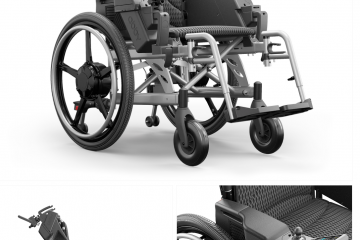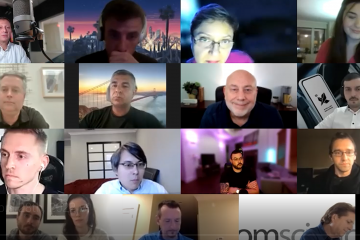January – A Quick Summary
We started our event by sharing a piece of great news.
For the month of January, we had two startups receiving offers from investors on our panel. In addition to the two offers, we have a third company in a review that can potentially also receive an offer.
Now, receiving an offer and actually agreeing to the terms are different things. We are now looking to hear back from the startup founders and see if the investment terms were favorable and accepted by the founders.
The Pitching Process
It seems like the process we have established works really well and startups and investors like it.
We stick to 5 minutes for pitching and another 5 minutes for investors Q & A session. This format gives a startup good 10 minutes to explain what they do and to communicate with the investors.
In addition, the breakout rooms continue to be accepted by founders and investors as a valuable part of the event. This allows the investors to have one-on-one quick conversations with the founders and eventually get connected to talk further about potential partnerships.
Startups That Pitched At The February 3rd Online Event
TANA Therapeutics
Kiet Ly presents his startup TANA Therapeutics
TANA Therapeutics has taken a ground-breaking leap in innovating the traditional TAT cell-permeating peptide (CPP) to construct “an extraordinary (intracellular) delivery tool” gaining accolades from a prominent CPP company founder during TANA’s scientific article review.
We’re witnessing a new medical age dominated by intracellular treatment approaches for gene expression, gene editing, and tissue engineering. Vaccinations from key players such as JnJ, Moderna, and Pfizer would have been inconceivable without an intracellular delivery tool (IDT) used for DNA/mRNA therapeutics transportation into cells. This process eventually triggers cells to produce spike proteins. IDTs exploit the cell’s “endocytic pathway” meant for drug delivery or payload transportation.
Reaching optimal utilization of the endocytic pathway to accentuate payload delivery efficacy marks a laudable achievement in IDT. Lipid nanoparticles (LPN) and AAV (viral vector), the IDTs found in Moderna/Pfizer and JnJ’s creations, have only been successful in hitting a delivery efficiency of roughly 50%. While these vaccines have made $10s Billion, they leave ample room for significant amelioration. Subsequently, this opens an avenue to tweak drug dosages for effectiveness, albeit with a heightened risk of side effects.
Our IDT, TANA-Porter, has set a new standard by achieving a payload delivery efficiency surpassing 90% while maintaining minimal toxicity (over 95% cell survival) – unmatched feats within the realm of accessible IDTs. Additionally, compared to CPPs, LPNs and viral vectors present a higher risk of immunogenicity and genotoxicity. Production and storage of these vectors also entail scalability issues, as experienced during Covid vaccination processes. Remarkably, CPPs are generally simple to produce and store, qualifying them as highly scalable, notwithstanding most CPPs’ struggle with subpar delivery efficiency.
TANA-Porter has masterfully countered this drawback. Furthermore, TANA-Porter doesn’t bind to payloads, allowing for uniform payload delivery without requiring conjugation or alteration of the payload’s molecular construct. TANA-Porter is a straightforward mix-and-use remedy.
Our operative strategy at TANA fully capitalizes on the adaptability of TANA-Porter to generate income. In the short run, TANA-Porter will be marketed as an intracellular delivery instrument solely for Research Use (RUO) in fundamental science labs for R&D purposes. RUO approval can be attained within 24 months, and the RUO IDT market is valued over $1billion.
Mid-term: The distinct setup of TANA-Porter, which lacks payload binding, allows its utilization as an ingredient or excipient in approved drugs or chemotherapies that work within cells. TANA-Porter’s role is to augment the intracellular availability of medications, hence enhancing medicinal efficacy while minimizing dosages, ultimately leading to reduced toxicity and fewer side effects – the predominant obstacles in maximizing a drug’s potential. Such an IDT would drastically increase in value.
EXORDI
Carlo Scaglia presents his startup EXORDI.
Harnessing the potential of artificial intelligence (AI) and machine learning (ML), EXORDI presents a unique and robust range of specialized content for marketing agencies. Scaling their operations poses an uphill task for these agencies, often deploying teams around the globe for content generation with whom they might lack comprehensive familiarity.
EXORDI breaks ground with its integration of top-level content creators, irrespective of their number of followers. ML technology is utilized to connect these creators with our standardized project guidelines, accessible on our platform. This novel methodology has proven successful in slashing production expenses and timelines by 50% while simultaneously amplifying average Key Performance Indicators (KPIs).
Currently diversifying our resource allocation, our focus lies in the development of a text-to-vision AI. This sophisticated tool conducts an in-depth analysis of the content we market, assigns content tags appropriately, and identifies top-performing tags. Procuring this information enables us to architect a content blueprint artificially — a solid foundation for our creators.
Our formidable team comprises three central figures — Myself, Martina, and Sumedha — an accomplished entrepreneur who accomplished her first business exit at a young age of 19. A proficient team of college engineers provides indispensable support. Within a short three month period since its inception, EXORDI has witnessed a tripling of its creator base, and our potential client waitlist — boasting household names like Pepsi, Powerade, Claires, and Buzzfeed — has doubled.
Although EXORDI grapples with contenders like Social Natives, Vidzy, and Billo, we’ve navigated to a distinct market niche through adopting a comprehensive B2B focus. We cater primarily to marketing, media, communication, and advertising agencies. Our winning formula lies in our neutrality towards influencers and the avoidance of blueprint generation for high-performing content from competitor firms.
Currently, we channel most of our efforts towards sports and outdoor content production. Yet, we envision encompassing all passion-driven subjects, incorporating music, art, food, and fashion. By doing so, we aspire to build the broadest segmented audiences, making EXORDI synonymous with the ultimate hub for Passion and Talent.
Vertical Growth
Dan Melton presents his startup Vertical Growth.
The Vertical Growth Farming System (VGFS) is a pioneering approach to address global malnutrition and hunger. Known for its robust construction, remarkable crop yield and adaptability across the globe, VGFS offers a cost-effective solution to government entities, on local, state, and national levels, and non-profit organizations in their fight against world hunger.
The VGFS is designed around a typical 20′ shipping container upgraded to integrate four primary modules:
- Tube Array -Crop Tube Assembly – The signature element of the VGFS is its 60 crop tubes which collectively host 2,160 “plant nodes”. Through hydroponic feeding techniques, it allows several annual harvests of both local and exotic crops with modest water usage.
- Solar Panels -Installed on top of the correctly situated container, the solar panels produce substantial electrical power to run the varied subsystems. The energy generated is retained in specially designated batteries.
- Grow Room -This is the dedicated section where young plants are cared for before they are moved to the crop tubes.
- Cold Storage -Anticipating that not all harvested crops will be used or sold immediately, VGFS includes provisions for short-term food storage. A compact AC system maintains ideal cooling conditions.
While the farming cycle employed by VGFS does not differ greatly from traditional farming methods, this system allows for the concurrent growth of seedlings and crops, significantly increasing the annual yield. Additionally, the vertical farming technique dramatically reduces the required land area, measuring just 8′ x 46′ (2.44m x 14.02m). At present, a fully operational prototype is in development, with notable progress made in securing key components, particularly commercial off-the-shelf (COTS).
The plan for the crop tubes and associated trellis system has been conceived, and its build is currently being scheduled. Non-COTS components have been identified and potential vendors are being contacted. The project is helmed by Dandridge Melton, a seasoned inhabitant of San Luis Obispo, CA and an accomplished serial entrepreneur. Along with his team of experts in solar energy, hydroponics, and system maintenance and operations, they are committed to providing a system that can help alleviate world hunger.
If you are interested in learning more or believe you could contribute to this project, feel free to reach out to dan@verticalgrowth.farm
LiVert
Feliana Citradewi presents her startup LiVert.
Heralding a path-breaking approach, LiVert positions itself as a pioneer, connecting nearby customers making purchases from the same e-commerce platforms. It is an ingenious start-up aimed at providing options for group buying, leading to complimentary and eco-friendly deliveries.
Trio founders: From different walks of life to France, our professional journeys crossed paths, creating an impactful collaborative strength triggered by our complementary expertise and joint zeal for the LiVert project.
The formidable CEO, Feliana Citradewi, came through in flying colors in a nation-wide business contest during her high school years. Barely 16, Feliana began weaving together an inventive idea, marrying traditional and modern elements.
An alumnus of Polytechnique, the dynamic CTO Rahul Kapoor, developed a unique passion for web development from an early age, which led to the birth of his first e-learning startup back in India.
Anass Abdelilah, our expert CMO, possesses in-depth knowledge in data marketing and e-commerce. Launching his career at 18, this diligent entrepreneur earned his stripes as an accredited Shopify manager.
Problem/Solution:
On the one hand, LiVert serves as a catalyst for group online shipping solutions, while it on the other hand, assists brands in reclaiming deserted shopping carts, with 60% of these abandonment occurring due to hefty delivery charges.
LiVert ingeniously calculates the minimum number of local consumers required for no-cost delivery on each of its partner e-commerce sites using its ground-breaking algorithm.
Consumer side:
Grouping purchases through LiVert : LiVert allows them to opt for group purchases, which not only drastically curtails the environmental effect of the final delivery leg (less than 750g CO2 per order) but also reduces the use of packaging. Brand side: Teaming up with ShopMate escorts customers towards complimentary delivery by amalgamating orders with others. This strategy hinders shopping cart desertion by presenting free and eco-friendlier delivery choices.
Market fit:
The proof of LiVert’s successful streak is demonstrated by its LinkedIn post that racked up over 17,000 non-promotional likes within a week and soared past 1 million views.
Market:
- E-commerce in France = € 100 billion
- Abandoned carts = 75% of purchases started
- 60% are caused by delivery costs
- 75% of shoppers showed intent towards group deliveries
- Spawning a potential € 20 billion market for LiVert
Business model:
Operating on a commission fee model, LiVert witnesses 10% of earnings coming in from association brands, which include more than 150 big names like Amazon, Shein, Castorama, etc
KPI’s:
- B2C 4000 active users
- Over 2000 delivery pooling preferences
- 100 successfully paired orders and purchases
Grants / BPI:
Receiving a grant of 30K€ from BPI, a French bank subsidy, LiVert operates with a manageable monthly outflow of approximately 1K€. This provides the venture with a breathing space for eight to ten months without any inbound revenue.
Deal:
Post-investment, LiVert has been valued at 1$ million, with a forecasted future valuation of 10$ million.
labr
Jeffrey Monson presents his startup labr.
Let’s make the quest for valuable connections simpler and quicker. Jeffrey Monson introduces his new venture, Labr – a tool envisioned to streamline the task of people-searching, kindling meaningful interactions and promoting workplace openness. Labr lets users sift through their previous work relations, providing a window into their team’s overall wellbeing.
Everyday encounters revolve around meeting people, whether we’re hunting for the right job, trying to bag a new client, or onboarding a new team player. Conventionally, we rely on the network of contacts we possess; they often get us the best opportunities before the world has a taste of it. Yet, this tactic falls short in scalability. It’s impractical to be in touch with hundreds of network members, hoping they do the same.
That’s where Jeffrey Monson’s latest venture, Labr, comes into the picture. Labr weaves a human web intertwining individuals and their association with organizations and teams, effectively mapping their work compatibility. Every link on Labr’s platform holds a value, representing the bond’s power. Aspects like the duration and freshness of the relation, as well as the depth of previous work engagements, collectively decide this value – not the count of emails, calendar meetings, or LinkedIn connections. Furthermore, Labr charts work-style compatibility, detailing how each user’s work patterns align with others in similar professional circles. This allows the system to generate new people recommendations drawn from users’ alike networks – if we both have a common pool of professional associates, and there’s someone you enjoy working with whom I’ve yet to connect, Labr suggests that person.
Performance appraisals foster Labr’s data gathering and are a critical Labr characteristic. Teams can schedule feedback periods on a monthly or quarterly basis, revealing work conduct and compatibility track records. Compatibility ratings across the entire network help spot troublesome managers or clients and, through diversity and inclusion features, highlight any workplace prejudice.
In its initial phase, the focus is on aiding professionals who demand assistance in sales/CRM, recruiting, staffing, or performance assessment.
Labr has its sights set on future markets like academia (for student-college matchmaking and admissions) and healthcare (for patient-doctor pairing). Labr’s potential outreach could touch billions, endorsing a massive Total Addressable Market (TAM).
Phytoverse
Jordan Askew presents his startup Phytoverse.
THE PITCH
An exciting potential to secure a 5X return on your investment within a timeframe of 90–120 days, forecasted to be achieved through our primary NFT launch sale.
THE BUSINESS
Phytoverse, Inc. is dedicated to providing digital amusement offerings to its community by way of a WebGL-supported metaverse, or Phytoverse™. It includes diverse, thematically structured planets, powered by an NFT-facilitated digital passport. Apart from this, it’s maintained by an intrinsic P2P metaverse economy. An evolution towards a mobile application, compatible with this web-centric platform, is in the pipelines.
THE PROBLEM
One substantial hurdle that needs addressing is the physical navigation or movement of users within any given metaverse. The process is often tedious, restraining, stagnant and primarily, time-intensive. Existing metaverse users have no option but to guide their avatars manually from one location to another or navigate using static portal infrastructure.
OUR SOLUTION
Phyto Pass, our proposed solution to the aforementioned trouble, is a digitally formatted access pass, conceptualized as a multifaceted DAPP. The Phyto Pass serves as a uniquely powerful digital passport and portal creator capable of transporting a user’s avatar to any chosen destination. Initially restricted to Phytoverse, it’ll widen its scope to essential areas within other metaverses as collaboration expands. Cutting-edge features include P2P messaging function and “lazy.com” styled dashboard portfolio management, incorporating coins, tokens, game assets, and land assets.
POTENTIAL RETURN/REVENUE MODEL
Primary returns come from our Generative NFT’s monumental 10,000 launch on the Solana blockchain. Listed at $450, the NFT grants early entrants sole rights to the Phyto Pass Device and a plot of land located on the Phytoverse Home planet. These privileged users are offered lifetime VIP status in Phytoverse. Other participants will have to maintain a metaverse subscription to access the majority of verse zones and top-tier features.
COMPETITIVE ADVANTAGE
Notable adversaries in the metaverse industry currently include Decentraland and Sandbox. Phytoverse, Inc. adopts a “plug and play” theme in our metaverse, effectively avoiding head-on competition. Instead, it allows us to focus on cooperative metaverse solutions catering to all verse users. Our cooperative revenue strategy prompts us to establish partnerships and extend our revolutionary metaverse navigation solution. Our groundbreaking solution to the travel issue will enjoy legal protection via a patent.



0 Comments